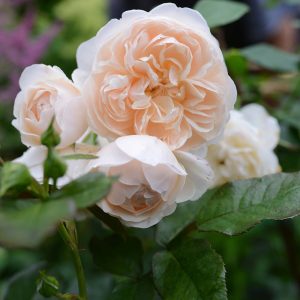Description
Widely referred to as columbine, it is found naturally throughout the temperate regions of the Northern Hemisphere, mostly in forests and meadows. A classic cottage garden perennial plant they are known for their easy nature and have a habit of self-seeding in the surrounding area. They can be found with flowers of a wide range of colours including pink, red, purple, blue and white as well as bicolour varieties.
Key Facts
- Common Name(s):Columbine Rose and White [Spring Magic]
- Hardiness:Fully hardy
- How big will I get? Aquilegia ‘Rose & White’ [Spring Magic Series] can grow to a height of 0.5m and a spread of 0.5m.
- Did You Know That:The name columbine comes from the Latin for Dove due to the resemblance of the flower to a cluster of doves?
Plant Calendar
A rough guide to how this plant will change through the year.
| Jan | Feb | Mar | Apr | May | June | July | Aug | Sept | Oct | Nov | Dec | |
| Flowering Time |  
|  
| ||||||||||
| Foliage Colour |  |
 |
 |
 |
 |
 |
 |
 |
 |
| J | F | M | A | M | J | J | A | S | O | N | D |
 
|  
| ||||||||||
 |
 |
 |
 |
 |
 |
 |
 |
 |
Care Guide

Soil Requirements
Aquilegia ‘Rose & White’ [Spring Magic Series] prefers soil with good drainage and does not tolerate standing water. This plant can grow in soil with a wide range of pH levels, it is not picky about the pH level of the soil.

Best Position
Aquilegia ‘Rose & White’ [Spring Magic Series] can handle either an exposed or a sheltered position and can cope with either full sun or partial shade.

Maintenance
Aquilegia ‘Rose & White’ [Spring Magic Series] are known to aggressively self-seed so the level of pruning they require depends on whether you want more Aquilegia popping up in the area. They are fairly short-lived perennials so it is recommended you either let them self-seed or collect the seeds by wrapping the ripe seed head into a bag and shaking it. If you don’t want the plant to self-seed the best approach is to deadhead them after flowering or even cut them back to ground level.

Pest, Diseases and Wildlife
Aquilegia ‘Rose & White’ [Spring Magic Series] can have problems with aphids and leaf miners, it can be vulnerable to certain diseases such as powdery mildews. It is also known to attract bees, butterflies and other pollinators. It is toxic to cats, dogs, horses and people.





